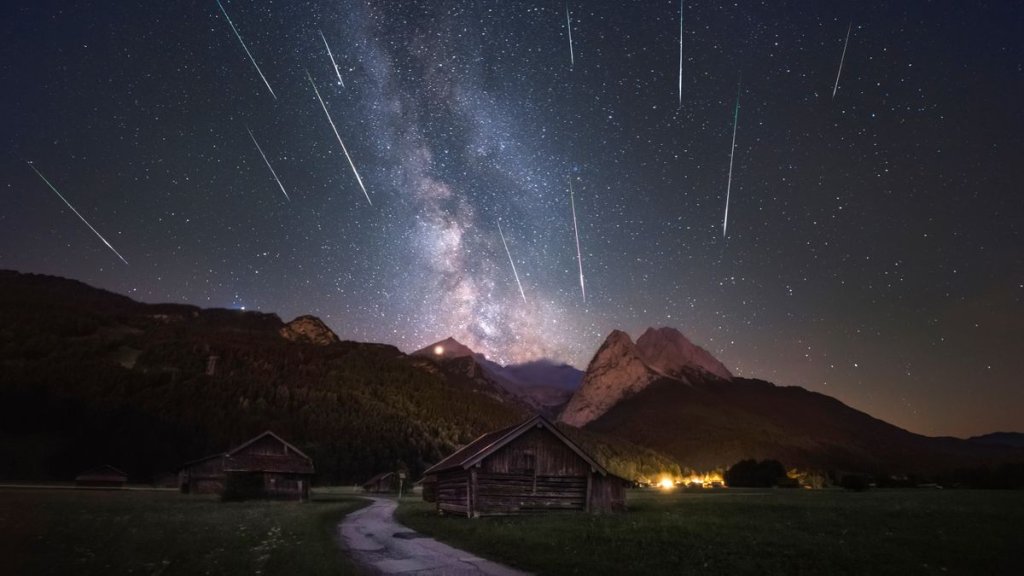
The 2023 Perseid meteor shower peaks this weekend! Here’s what you need to know. (Image Credit: Space.com)
The Perseid meteor shower will peak this weekend as Earth makes a yearly dive through debris left behind by a Comet 109P/Swift-Tuttle.
The peak activity of the Perseid meteor shower will occur around 04:00 EDT (0800 GMT) on Sunday. Aug. 13.
The Perseids are a yearly highlight for meteor hunters who, in the right conditions, could see as many as 100 fireballs and light trails per hour from the meteor shower, according to the Royal Museums Greenwich, with even more potentially visible at the shower’s peak.
This year the Perseid meteor shower is active between July 17 and Aug. 24. The Perseids takes its name from the fact that its meteors appear to streak towards Earth from the constellation Perseus. Astronomers call the point from which meteors appear to stream the radiant.
This means the best time to see the Perseid meteor shower is when the radiant in Perseus is above the horizon. For skywatchers based in New York City, the radiant point of the Perseids is circumpolar, which means it is always overhead, meaning the meteor shower is visible all night after the sun has set and the sky has darkened.
Related: Meteor showers 2023: When is the next one?
From New York City on Sunday, meteor hunters should see the radiant of the Perseids at around 70⁰ over the horizon. The moon will be close to its new moon phase, meaning it is almost absent from the night sky, with the lack of moonlight providing dark skies that are ideal for spotting meteors.
In favorable weather and away from Earth-based light sources, In the Sky estimates that sky watchers observing the Perseids peak on Sunday could see as many as 141 meteors per hour.
The meteors of the Perseids may appear to stream to Earth from the distant stars of the constellation Perseus, but the actual origin of the meteors is located in the solar system.

The Perseid meteor shower originates from a cloud of debris left in the inner solar system by the comet 109P/Swift-Tuttle, informally known as Comet Swift–Tuttle.
A 16-mile (26-kilometer) wide body of dust, ice, rock, and dark organic material, Comet Swift–Tuttle orbits the sun at a speed of 93,600 miles per hour. Despite traveling at speeds 60 times greater than the top speed of a jet fighter here on Earth, Comet Swift–Tuttle still takes a leisurely 133 Earth years to fully orbit the sun.
When the comet gets close to the sun, radiation from our star heats it causing solid ice to transform immediately into gas, a process called sublimation. As this gas escapes the comet, it blows away fragments of ice, dust, and rock. This is left around the sun as clouds of gritty debris, which flatten out, creating a stream of cometary material around the sun.
As Earth takes its own yearly trip around the sun, every summer between July and August it passes through this debris stream. As it does, fragments of ice and dust enter Earth’s atmosphere at speeds as great as 130,000 miles per hour.
The debris causes the air in front of it to be compressed and heated to thousands of degrees. As a result, at an altitude of between around 44 miles (70 km) and 62 miles (100 km) over Earth larger fragments of rock and ice explode as bright fireballs. Smaller fragments of debris can pass further into Earth’s atmosphere as they are being vaporized, with this more gradual destruction leaving longer streaks of light in their wake.

For skywatchers who want to see the Perseids at their peak and can’t get away from the bright lights of the city, the Virtual Telescope Project will live stream the event from its all-sky camera at its facility in Italy. Coming from the remote Maremma countryside, the telescope will enjoy the perfect dark skies from which to see the fireballs and bright streaks of the Perseids.
The free online live stream will start at 21:30 EDT on Saturday (01:30 GMT on Sunday) and can be viewed at the Virtual Telescope Project WebTV page, YouTube channel and here on Space.com courtesy of the Virtual Telescope Project.
If you are hoping to catch a look at the Perseid meteor shower for yourself, our guides to the best telescopes and binoculars are a great place to start.
If you’re looking to snap photos of the meteor shower or the night sky in general, check out our guide on how to photograph meteor showers, as well as our best cameras for astrophotography and best lenses for astrophotography.
Editor’s Note: If you snap an image of the Perseid meteor shower, and would like to share it with Space.com’s readers, send your photo(s), comments, and your name and location to spacephotos@space.com.





